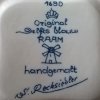Second half of the 16th century is a time of increase in majolica production in Italy and Spain. Majolica is a tin glazed earthenware. Italian and Spanish earthenware soon began to be imitated by potters from Netherlands. Moreover in the beggining of the 17th century these Dutch potters were met with chinese porcelain competition. The effect of the situation was creation of delftware. Potters in Netgerlands used the tin-glaze technique to imitate Chinese porcelain.
The center of the delftware production became Delft. The city gained in importance after fall of Antwerp, the largest Dutch city as well as cultural, economic and financial centre of Netherlands. In 1585 potters fleeing from Antwerp settled in Delft.
In 17th and 18th century Delft was a capital of European ceramics production. In 1710 in German Meissen began history of European porcelain, which also started to be produced in Netherlands. In 1840 there was only one delftsware company left - De Porceleyne Fles. Popularity od delftware returned in the second half of 19th century.
Here you can find clues how to date De Porceleyne Fles items.

